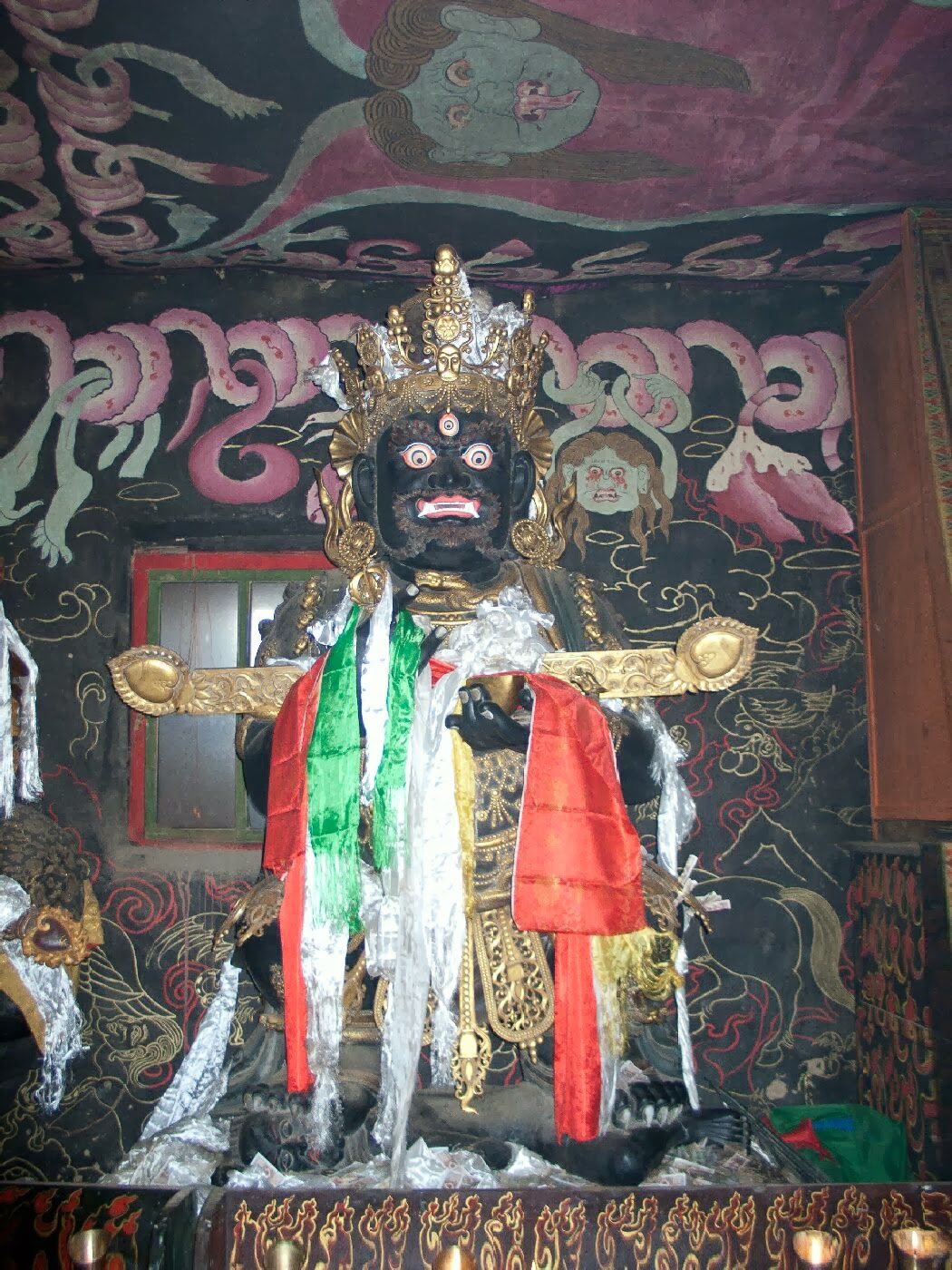Mahakala: Panjarnata, Lord of the Pavilion
Panjaranata Mahakala is the protector for the Shri Hevajra cycle of Tantras. The iconography and rituals are found in the 18th chapter of the Vajra Panjara Tantra (canopy, or pavilion) a Sanskrit language text from India, and an exclusive 'explanatory tantra' to the Hevajra Tantra itself. It is from the name of this tantra that this specific form of Mahakala is known. 'Vajra Panjara' means the vajra enclosure, egg shaped, created from vajra scepters large and small - all sizes, completely surrounding a Tantric Buddhist mandala. The name of the Tantra is Vajra Panjara and the name of the form of Mahakala taught in this Tantra is also Vajra Panjara. The full name for the protector is Vajra Panjara Nata Mahakala.
Western scholars, such as Laurence Austine Waddell and Albert Grunwedel, in the 19th and early 20th century believed that the meaning of the name was 'tent' and that this Mahakala was a special protector of the Tibetan and Mongolian nomads who lived in tents. This academically erroneous belief was however supported by Mongolian folk belief where they believed that Panjara Mahakala, originally introduced to Mongolia by Chogyal Pagpa in the 13th century, was indeed special for them based on the Chogyal Pagpa and Kublai Khan relationship. Panjara Mahakala was also used by Mongolians as a war standard during the time of Kublai Khan.
The 'Vajra Pavilion' when represented in mandala paintings or for three-dimensional mandalas is known as the 'Vajra Circle' (Sanskrit: vajravali): inside of the outer ring of a two-dimensional mandala, painting or textile, is a circle of fire and then a vajra circle. This vajra circle is often difficult to see and easy to dismiss as simply decorative. The circle is a series of gold or yellow vajras, painted against a dark blue or black background, lined up end to end and circling around the entire mandala, deity and palace. The vajra circle is not envisioned as flat or horizontal like the lotus circle. The vajras are seen as a three dimensional pavilion, without doors or windows, completely enclosing the mandala. It is made entirely of vajras, small and large with all of the openings filled with ever smaller vajras. It is a three-dimensional structure and impenetrable. Envisioned as a three-dimensional object it is called the Vajra Pavilion and according to function it is called the Outer Protection Chakra.
Lineage of Teachers: Vajradhara, Vajrapanjara Dakini, Brahmin Vararuchi, Pandita Deva Vajra, Shraddha Karavarma, Lochen Rinchen Zangpo, Drag Tengpa Yontan Tsultrim, Mal Lotsawa Lodro Drag, Sachen Kunga Nyingpo (1092-1158), etc.
Western scholars, such as Laurence Austine Waddell and Albert Grunwedel, in the 19th and early 20th century believed that the meaning of the name was 'tent' and that this Mahakala was a special protector of the Tibetan and Mongolian nomads who lived in tents. This academically erroneous belief was however supported by Mongolian folk belief where they believed that Panjara Mahakala, originally introduced to Mongolia by Chogyal Pagpa in the 13th century, was indeed special for them based on the Chogyal Pagpa and Kublai Khan relationship. Panjara Mahakala was also used by Mongolians as a war standard during the time of Kublai Khan.
The 'Vajra Pavilion' when represented in mandala paintings or for three-dimensional mandalas is known as the 'Vajra Circle' (Sanskrit: vajravali): inside of the outer ring of a two-dimensional mandala, painting or textile, is a circle of fire and then a vajra circle. This vajra circle is often difficult to see and easy to dismiss as simply decorative. The circle is a series of gold or yellow vajras, painted against a dark blue or black background, lined up end to end and circling around the entire mandala, deity and palace. The vajra circle is not envisioned as flat or horizontal like the lotus circle. The vajras are seen as a three dimensional pavilion, without doors or windows, completely enclosing the mandala. It is made entirely of vajras, small and large with all of the openings filled with ever smaller vajras. It is a three-dimensional structure and impenetrable. Envisioned as a three-dimensional object it is called the Vajra Pavilion and according to function it is called the Outer Protection Chakra.
Lineage of Teachers: Vajradhara, Vajrapanjara Dakini, Brahmin Vararuchi, Pandita Deva Vajra, Shraddha Karavarma, Lochen Rinchen Zangpo, Drag Tengpa Yontan Tsultrim, Mal Lotsawa Lodro Drag, Sachen Kunga Nyingpo (1092-1158), etc.











































.jpg)
.jpg)
.jpg)
.jpg)
.jpg)
.jpg)
.jpg)
.jpg)
.jpg)
.jpg)
.jpg)
.jpg)
.jpg)
.jpg)
.jpg)
.jpg)
.jpg)
.jpg)





No comments:
Post a Comment